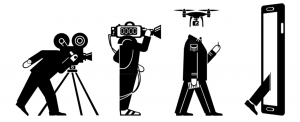[insert social media optimized thumbnail image here]
Nearly 30 days have passed in my residency, and yet I’ve only posted three blog posts in that time. This is much less than I expected to post, and to be honest, it’s been a source of persistent vexation in the back of my mind. With each significant experience or development during my stay, the thought flashes through my mind: I should blog about this. Even in my chats with Volker, when I mention something that happened or some item that occupies my thoughts, he offers the reply, “It would be nice to write about this on the Residency blog.” The paradox is this: so much has happened in the past month that is worth blogging about, but the problem is that I’m not left with much time to blog.
Or is that really true?
Since my arrival to the Residency on December 28, while only 3 blog posts occupy this space, I have done the following activities elsewhere:
Instagram posts: 26
Facebook posts: 15
Tweets: 14
I can attribute this disparity to habit. I haven’t kept a regular blog since 2010, when I concluded my Shooting Down Pictures project (the genesis for my video essay work). Around that same time my online activity migrated heavily to Facebook and Twitter, and later to Instagram, where I am presently most active. Instagram probably appeals to me most because it’s the most visual of the platforms, the easiest to skim casually, and the least likely to be populated with negative content – for these three reasons, it simply gives me the most pleasure.).
So to take up this blog has required some adjustment of my social media routines and behavioral patterns… but it has also triggered a more philosophical question: what exactly is a blog good for in 2017? I am a bit saddened to reflect on this question, because it was a little over ten years ago that I started my blog project, which proved to be a major catalyst for the development of my critical voice with regards to film, and enabled the work that I am now most known for. Volker Pantenburg, who created the Residency blog for me, was blogging well before I was, being an active participant on the German film criticism blog Newfilmkritik.de – though from what I understand, even expressed some disillusionment with the limitations of blog culture as early as the mid-2000s. Nonetheless, he has seemed particularly keen on having me blog. Perhaps it’s not insignificant that he isn’t active on the social media platforms that are my first options for posting online.
So this has triggered some reflection on just what blogs are good for in an age where less content-intensive, more easily browsable forms of social media has taken the lion’s share of people’s online activity. Those social media platforms occupied me more than ever this past year, not just personally but professionally (and if I have time, I’ll blog more about this). As it happens, my professional experiences producing content specifically targeted for social media platforms have left me disillusioned, and also resulted in more than half my career body of work being eliminated from the internet (again, more on this if time permits). And those outcomes in turn have left me wondering just what is lasting, permanent and real about internet culture. On the one hand, my former blog Shooting Down Pictures is in disrepair, which may have had some discouraging influence as I considered how much time and energy to expend on the Farocki Residence blog. On the other hand, Instagram, Facebook and Twitter seem predicated on a constant stream of content to the point that flattens everything into a endlessly rolling landscape of moments that feel important enough to capture and share, but quickly recede into the backlog.
So again, I wonder what any and all of this is really good for. But perhaps utility isn’t really the point, or at least it doesn’t have to be. I am reminded of the final lines of Farocki’s Parallel I, where the voiceover observes that the advanced computer generated imagery of our time has stolen photography’s century-long claim of most accurately capturing reality, the same claim it stole from painting in the 19th century. Farocki then issues the same challenge to contemporary photography that painting faced with the advent of the photograph: to discover what else it can do once it is liberated from the burden of serving its longstanding functional purpose. In other words, to be more like an artist.
I see this same proposition for the state of blogging in 2017 – how can it occupy some alternative, contradictory purpose to mainstream social media and online activity. Maybe it’s to be as unsocial as possible, or to interrogate and redefine what “social” means in the online space. To be free of the social media economy of imminent circulation, likes and shares, and find value in other modes – stasis, marginality, un-shareability. To find fulfillment simply in itself.
